You're using an outdated browser. Please upgrade to a modern browser for the best experience.
Please note this is a comparison between Version 1 by Shudong Lin and Version 3 by Rita Xu.
As technology develops at a rapid pace, electromagnetic and radiation pollution have become significant issues. These forms of pollution can cause many important environmental issues. If they are not properly managed and addressed, they will be everywhere in the global biosphere, and they will have devastating impacts on human health. In addition to minimizing sources of electromagnetic radiation, the development of lightweight composite shielding materials to address interference from radiation has become an important area of research. A suitable shielding material can effectively reduce the harm caused by electromagnetic interference/radiation.
- electromagnetic radiation
- radiation
- membrane shielding materials
1. Introduction
With the advent of the 5G era, the number of electronic devices has grown exponentially (Figure 1) [1]. However, mobile phones, computers, and radar systems generate electromagnetic pollution, which can seriously interfere with people’s lives and the use of other electronic products and can even pose serious threats to human health while also disrupting the normal operation of devices [2][3][4][5][6][2,3,4,5,6]. In addition, as governments seek to find reliable energy sources, the application of nuclear energy is becoming increasingly common (Figure 2) [7]. The radiation generated during the operation of high-end scientific and technological equipment causes various forms of radiation pollution such as medical radiation [8], nuclear reactor radiation [9], scientific research radiation [10] and industrial radiation [11], which are harmful to human health and the environment similar to water pollution and air pollution in modern life. Therefore, it is imperative to find a reasonable and effective method to solve the above problems [12][13][14][15][16][12,13,14,15,16].
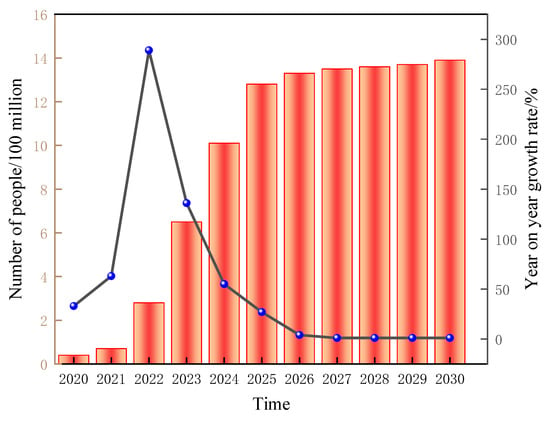
Figure 1. Forecasted numbers of 5G subscribers in China from 2020 to 2030.
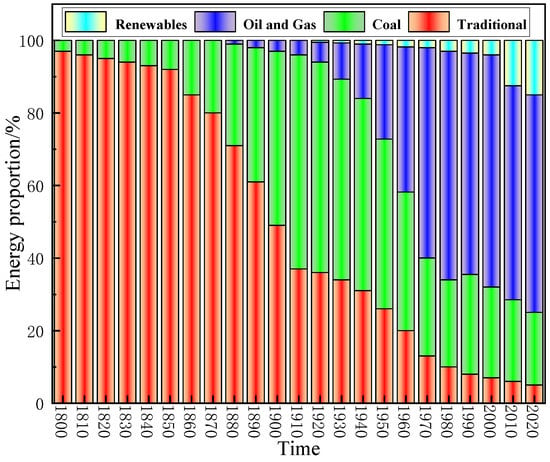
Figure 2. Share of global energy consumed and the change in global primary energy consumption.
The use of membrane shielding material is a very effective electromagnetic/radiation protection method, which can reduce the radiation by reflection or absorption, especially when the distance and time are limited [17][18][19][17,18,19]. In order to obtain a good shielding effect, appropriate shielding materials should be selected that are appropriate for the given application. Therefore, it is necessary to study the performance characteristics of membrane shielding materials with potential electromagnetic/radiation pollution. In order to handle the environmental pollution caused by electromagnetic/radiation, different membrane shielding materials have been produced to protect human beings and their environment from the destructive effects of electromagnetic/radiation [20][21][22][20,21,22]. When looking for suitable membrane shielding materials, the weight, space, and cost of membrane shielding materials are the primary problems faced by researchers. More importantly, lightweight, non-toxic, and flexible membrane shielding materials with robust mechanical properties and good shielding effects are the common goal pursued by researchers.
For many years, researchers have studied numerous kinds of membrane shielding materials to deal with radiation pollution caused by electromagnetic/radiation, such as metal-based [23][24][25][23,24,25], polymer-based [26][27][28][26,27,28], concrete-based [9][29][30][9,29,30], lead-based [31][32][33][31,32,33], boron-based [34] materials, as well as other examples of widely used membrane shielding materials. However, with the rapid pace of technological development, the above-mentioned membrane shielding materials can no longer meet the problem of electromagnetic/radiation pollution caused by many types of modern technological devices. Therefore, more researchers have devoted themselves to the exploration of membrane shielding materials to protect humans and their environment, and these efforts have expanded to the preparation of many new membrane-based shielding materials, such as the use of 3D printing design [35][36][37][38][35,36,37,38], as well as the development of MXene-based [39][40][41][42][39,40,41,42], carbon-based [43][44][45][46][43,44,45,46], iron-based [47][48][49][50][47,48,49,50], cellulose-based [51][52][53][54][51,52,53,54], and lead-free materials [55][56][57][58][59][60][55,56,57,58,59,60]. The traditional electromagnetic/radiation shielding method was to directly blend conductive fillers to improve the shielding performance [61], especially in the field of electromagnetic radiation shielding. However, it was not easy for the fillers to form an effective continuous network, which made it difficult for electrons to pass through the polymer matrix and hindered efforts to improve the effectiveness of the membrane shielding materials [62]. In addition, commonly used radiation shielding materials are mostly concrete and metals (such as lead, tungsten, iron, etc.) [23][24][25][29][30][23,24,25,29,30]. However, concrete has some disadvantages, such as large volume, difficult movement, and poor compressive capacity [9][29][30][9,29,30]. Meanwhile, boron-containing stainless steel has a higher density [34]. Common heavy metals are often toxic, heavy in weight, have a poor melting point, low mechanical strength, and offer poor shielding performance against neutrons [31][32][33][31,32,33]. Fortunately, with the in-depth understanding of the mechanism of membrane shielding and extensive research on the raw materials and preparation technology of membrane shielding materials, efforts were underway to address the above problems.
With the rapid development of electronics, components and nuclear power sources, comprehensive strategies, and to alleviate and control electromagnetic/radiation pollution have been put forward, and composite membrane shielding materials have quickly gained the attention of researchers. Compared with traditional concrete and heavy metal shielding materials, composite polymer-based materials in which a polymer comprises the matrix and nanomaterials are introduced as fillers that have the advantages of easy molding, light in weight, relatively inexpensive, etc., and thus these materials are promising candidates for applications in aerospace, nuclear power plants, and medical devices [63][64][65][63,64,65]. Most polymer substrates are polymers, such as polyurethane [66][67][66,67] and nanofibers [54][68][69][70][54,68,69,70]. Nanofillers include composite shielding materials such as metal-based materials [71][72][71,72], MXene-based materials [73][74][75][76][73,74,75,76], carbon-based materials [77][78][79][80][77,78,79,80], and so forth. They have different forms so that they can are suitable for different fields. The combination of a nanofiller and polymer matrix can obtain excellent shielding performance and various unique functions [81]. Therefore, the effective strategy to enhance the electromagnetic interference/radiation shielding performance and meet the actual needs was to construct a hybrid system comprised of a single material combined with multiple materials, thereby integrating the desirable characteristics of different materials and expanding their applicability.
2. Novel Electromagnetic/Radiation Shielding Membrane Materials and Technologies
2.1. 3D Printing Design of Membrane Shielding Materials
Although the above solutions have effectively promoted the development of membrane shielding composite materials and have addressed the issues arising from electromagnetic radiation to a certain extent, these materials still have some shortcomings, such as the need for complicated preparation processes, a long production cycle, expensive production equipment, and poor shielding efficiency in special fields. Among the many manufacturing technologies available to generate membrane-based shielding materials, 3D printing technology is one of the latest frontiers in the manufacturing field. It was particularly used to design and prepare complex shapes and structures that are difficult to manufacture by traditional technologies, and this approach has been widely used in various high-tech fields [82][126]. 3D printing can be controlled by a computer, thus reducing labor costs. In the process of shielding material preparation, it was usually necessary to lay some special materials for continuous layers., such as metal alloy, polylactic acid, graphene, carbon nanotubes, MXene, etc., which increases the cutting and designability of the structure and expands the potential applicability of 3D printing technology in various fields [35]. Due to the unique layer-by-layer stacking method used for this approach, 3D printing shows an exciting prospect. Shi et al. [83][127] introduced graphene nanosheets (GNs) into a polylactic acid matrix by a solution blending method, and they prepared a promising multifunctional filament (Figure 3a), which endowed the composite filament with ideal thermal conductivity and shielding performance, which reached 3.22 W/m·k and 34.9 dB, respectively, and the shielding efficiency of EWMs energy was 99.97% (Figure 3b). Thereafter, in order to explore the manufacturing potential of potential applications of 3D printing technology, an ideal material with a free structure and excellent performance was constructed. Especially in thermal management, the corresponding initial heat dissipation rate was 266% higher than that of pure radiator. At the same time, the mechanism was explored, mainly because multifunctional filament electron transfer played a key role in heat flow (Figure 3c). In addition, the shielding module obtained via 3D printing has high shielding performance (35.8 dB) under a specific Bluetooth interactive signal (2.4 GHz) (Figure 3d). In general, this innovative research not only enriches the printable materials with customized multifunctional features but is also anticipated to provide a promising route toward the next generation of multifunctional devices with applications in modern electronic engineering and great market competitiveness.


Figure 3. (a) Schematic diagram of the preparation process leading to PLA@GNS filament. (b) a−b: thermal conductivity and electrical conductivity of PLA@GNS nanocomposites, c: EMI SE characteristics of PLA@GNS nanocomposites as a function of frequency, d: and corresponding electromagnetic parameters and EMWs transmittance. (c) a: chemical diagram of heat sink model, b−c: 3D printed digital and super-depth-of-field images of heat sinks, d: heat dissipation curves of pure PLA and PG9.08 filaments prepared via different thermal management environments: metal and foam substrates, e: representative infrared thermal images of heat dissipation behavior of pure PLA and PG9.08 heat sinks on metal substrates, f: corresponding initial heat dissipation rates on metal and foam substrates, g: Schematic diagram of heat dissipation mechanism of pure PLA and PLA@GNs heat sinks. (d) Schematic diagram of EMWs shielding module.
3D printing technology can provide a high degree of control over the microporous structure of the resultant material, thus facilitating efforts to achieve the functions and properties required by EMI shielding materials. Liu et al. [84][128] used 3D printing technology to construct a Ti3C2Tx/GO framework with a vertical pore gradient and then cured and annealed the 3D framework with PDMS to prepare a TiO2-Ti3C2Tx/rGO/PDMS composite with high shielding efficiency (Figure 4a). It was worth noting that this membrane shielding material has a unique multi-layered scale structure. In addition, simulation studies have been employed to investigate the influence of the gradient aperture on the electromagnetic interference of composite materials. Under the synergistic effect of multiple loss mechanisms, the designed composite exhibits a conductivity as high as 173.1 S/m and an excellent EMI SE of 58 dB. The same shielding material also has excellent thermal management performance. The porous structure prepared in this study fully demonstrates the potential of personalized design and customization using 3D printing technology, thus broadening the potential applications of 3D printing technology in the field of electromagnetic/radiation membrane shielding materials. Generally, membrane shielding materials with porous structures can promote the internal reflection and scattering of electromagnetic waves, and often have better shielding effectiveness than non-porous materials. Pei et al. [85][129] prepared porous CNT/Ti3C2Tx/CS composites by a combination of ball milling technology and 3D printing technology (Figure 4b,c). It was found that CNTs and Ti3C2Tx were uniformly dispersed in the polymer matrix, which is conducive to the construction of a conductive network thus improves the electromagnetic shielding performance of 3D printing devices, which can reach 23.5 dB. In addition, melting deposition modeling (FDM) 3D printing technology makes use of the orientation of melt flow during polymer extrusion, which enables the orderly arrangement of fillers as well as the convenient and efficient construction of the filler network. Ma et al. [82][126] used FDM 3D printing technology to prepare ordered GNPs/PLA sheets with PLA and graphene nanosheets (GNPs) as auxiliary materials. Then, a Ti3C2Tx /(O-GNPs/PLA) composite material with good shielding performance and thermal conductivity was prepared by “layer-by-layer lamination-hot pressing” technology and vacuum-assisted filtration (Figure 4d). Its thermal conductivity and shielding effectiveness were as high as 3.44 W·m−1·K−1 and 65 dB, which are increased by 1223.1% and 2066.7%, respectively, compared with PLA matrix material (Figure 4e).
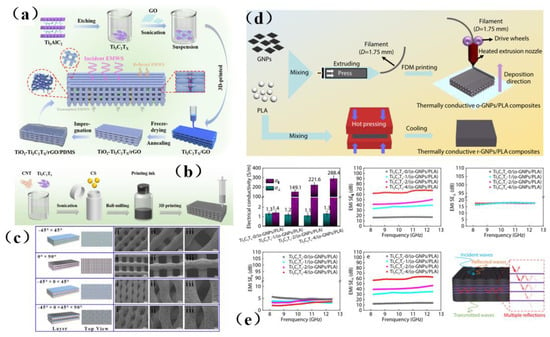

Figure 4. (a) Schematic diagram of preparation depicting the Ti3C2Tx/rGO/PDMS composite. (b) Preparation process of CNT/ Ti3C2Tx/CS ink and its 3D printing composite carbon nanotubes; CS, chitosan. (c) Schematic diagram depicting the preparation of porous 3D printed composites with different structures. (d) Schematic diagram depicting the preparation of thermal conductive GNPs/PLA composites. (e) EMI SE and EMI shielding diagram of Ti3C2TX/(O—GNP/PLA) thermal conductive composite.
In summary, the use of 3D printing technology to prepare electromagnetic interference shielding materials reduces the need for tedious processes such as traditional laboratory synthesis and provides materials with better smoothness. At the same time, it can promote the overlapping of fillers and the efficient construction of polymer composites in the network, which is an efficient and simple strategy for preparing polymer composites with high thermal conductivity and excellent EMI SE. In addition, because of its good electromagnetic shielding performance, 3D printing technology has great potential for use in the development of portable electronic devices. Most importantly, 3D printing technology can also be optimized by computer software, and can freely manufacture various structures, with adjustable performance and numerous structural design options. Therefore, it was expected to innovate different printing methods, resulting in increased porosity, more interfaces and higher strength, thereby enhancing the electromagnetic shielding performance. However, only a limited range of materials were suitable for 3D printers, and the influence caused by gaps between successive layers, viscosity problems, were also significant challenges, which may be the limiting factors impeding its use and its application expansion. It was believed that with the introduction of 4D and 5D printing in the manufacturing industry, the shortcomings of 3D printing technology could be eliminated and more advanced materials could be manufactured via these technologies. The use and improvement of 3D printing technology will soon bring about a new revolutionary world.
2.2. MXene-Based Membrance Shielding Materials
With the increasing popularity of portable and wearable devices, materials that are light in weight, have a low density, are highly flexible, and have excellent mechanical stability are becoming highly sought-after for use as EMI shielding materials. Due to its excellent conductivity, MXene has been widely investigated and applied in the field of electromagnetic interference shielding, and it has thus become a very popular electromagnetic interference shielding material [39][40][41][42][39,40,41,42]. However, during the application of MXene, it was reported that the EMI SE of MXene/polymer electromagnetic interference shielding composites was relatively low, randomly distributed MXene cannot readily form an effective conductive path in the polymer, resulting in poor shielding performance [86][130]. On the basis of ion intercalation and ultrasonic-assisted preparation of low-layer high-conductivity Ti3C2Tx, Wang et al. [86][130] employed a low-temperature thermal reduction method to remove some polar groups from the surface of Ti3C2Tx. A Ti3C2Tx/epoxy electromagnetic interference shielding nanocomposite was subsequently prepared by a solution casting method, with shielding performance reaching as high as 41 dB. Research on its shielding mechanism shows that due to an impedance mismatch, part of the electromagnetic wave was reflected and absorbed by carrier interaction, and the rest was reflected and re-absorbed, thus causing more of the electromagnetic wave to be lost due to the presence of the shielding composite and fully attenuating the electromagnetic wave (Figure 5a). However, the demand for high shielding performance membrane shielding composites in the aerospace field was still facing challenges and further research was needed. In another study, Wang et al. [87][131] firstly prepared a low-level Ti3C2Tx MXene. Subsequently, porous Ti3C2Tx MXene/C composite foam (MCF) was prepared by a reduction method. An MCF/epoxy electromagnetic shielding nanocomposite with excellent shielding properties and mechanical properties was then prepared via vacuum-assisted impregnation and a curing process (Figure 5b). X-ray photoelectron spectroscopy (XPS) data show that MCF has a highly cross-linked network, so the membrane shielding material has robust mechanical properties. In addition, it has been found that absorption plays a dominant role in the shielding mechanism of MCF/ epoxy electromagnetic shielding nanocomposites, and the shielding performance reaches 46 dB (x band). MCF’s unique three-dimensional conductive network expands the range of applications for MXene membrane shielding materials into the field of electromagnetic interference shielding. Renewable porous biochar and two-dimensional MXene have attracted much attention in the field of high-end electromagnetic interference shielding because of their unique ordered structure and excellent conductivity. Liang et al. [88][132] prepared a MXene aerogel/wood-derived porous carbon (WPC) composite material with good conductivity and ultra-light weight properties by using porous carbon derived from natural wood (Figure 5c). Through a series of characterization methods (Figure 5d), it was demonstrated that the membrane is an excellent shielding material, and its shielding performance reaches as high as 71.3 dB. This kind of wall-like “mortar-brick” structure (in which the WPC skeleton is the “mortar” and the MXene aerogel is the “bricks”) not only effectively solves the structural instability of MXene aerogel network, but also greatly prolongs the propagation path of electromagnetic waves. It dissipates the incident electromagnetic waves in the form of heat energy and electric energy, thus showing superior EMI shielding performance (Figure 5e).


Figure 5. (a) Schematic diagram of shielding mechanism of annealed Ti3C2Tx/epoxy resin electromagnetic interference shielding nanocomposite. (b) Schematic diagram of preparation process leading to a MCF/epoxy electromagnetic shielding nanocomposite. (c) Schematic diagram depicting the preparation depicting the MXene aerogel/WPC composite. (d) a: TGA, b: XPS, c: FTIR, d: Raman, e: water absorption capacity, f: water contact angles of natural wood WPC-500, WPC-1000 and WPC-1500. (e) a: Photos of “stucco brick” structural walls. b: SEM images of MXene aerogel /WPC composites, d: element mapping images of Ti, e: EMI SE of MXene aerogel /WPC composite, f: Comparison of EMI SE values between MXene aerogel /WPC composite and WPC-1500, g: electromagnetic interference and SE value are the same as density, h: Schematic diagram of electromagnetic wave passing through MXene aerogel /WPC composite.
Although MXene membrane shielding materials have been widely used, how to use these materials as high-performance electromagnetic wave absorption and electromagnetic interference shielding materials and make them have multiple functions is still a great challenge. Zhen et al. [89][133] prepared a Ti3C2Tx/carbon nanotubes/Co nanoparticle (Ti3C2Tx/CNTs/Co) nanocomposite with a 2D/1D/0D structure via an electrostatic assembly method (Figure 6a). This membrane shielding material has highly integrated functions, including excellent electromagnetic wave absorption, EMI shielding efficiency, thermal cycle stability, photothermal conversion performance, flexibility, and hydrophobicity (Figure 6a). Similarly, hydrogels are rich in water pores, which are expected to promote the reflection of incident electromagnetic microwave (EMWs) and enhance the polarization loss ability of water molecules and hydrogen bond networks. This makes hydrogel promising as a high-performance EMI shielding material. Yang et al. [90][134] prepared a kind of electromagnetic interference (EMI) shielding material which integrates a honeycomb-like ordered porous structure, high conductivity MXene precipitates (MS)and water, and a highly flexible hydrogel, which is mainly composed of “garbage” MS and bionic pores (Figure 6b). This membrane shielding material not only had bionic ordered pore structure, but also possessed is a strong frame composed of highly crosslinked MS, which stabilizes the micron-sized pore structure and is more conducive to the formation of high-strength hydrogel with mechanical super-flexibility. Under the synergistic effect of this MS-based conductive network, 30 PVA chains, water and porous structure, MS-based hydrogel shows good EMI shielding performance, and more surprisingly, it has sensitive and reliable functions of human motion detection and intelligent coding. In addition, the pollution caused by the emission of thermal radiation also greatly affects human life. Therefore, there is an urgent need for multifunctional electronic skin with the functions of thermal radiation regulation and electromagnetic interference shielding. Song et al. [91][135] prepared a flexible electronics skin with Ti3C2Tx MXene as the conductive electrode (Figure 6c). It was found that this skin has flexible transmission power and high-performance shielding effectiveness of 36.3 dB. This technology could not have applicability in areas such as thermal radiation modulation and EMI shielding, but also provides technical and experimental guidance for the design of other multi-band spectral shielding materials. As part of their efforts to address the difficult processing and poor mechanical properties of MXene-based shielding materials, Wang et al. [92][136] prepared a three-dimensional highly conductive cellulose nanofiber/Ti3C2Tx MXene aerogel (CTA) with an oriented porous structure. They then thermally annealed the CTA to obtain thermally annealed (TCTA)/epoxy nanocomposites (Figure 6d). MXene and these materials were light weight, readily processable, moldable, had high EMI SE values, possessed excellent mechanical properties, and had good thermal stability.
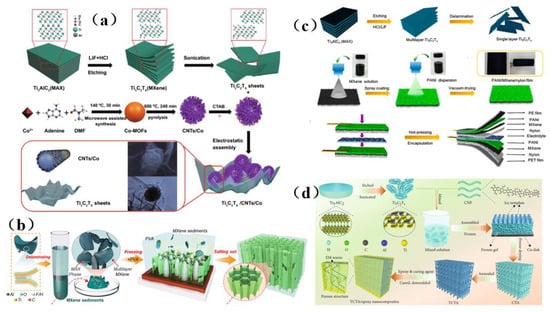

Figure 6. (a) Schematic diagram of the preparation pathway leading to a Ti3C2Tx/CNTs/Co nanocomposite and performance evaluation of this material. (b) Schematic diagram of preparation process of MS-based hydrogel. (c) Schematic depiction of the preparation of multifunctional skin. (d) Schematic diagram of TCTA/epoxy nanocomposites.
In conclusion, the preparation or processing of these commonly used MXene layers for use in membrane shielding materials still faces several challenges such as high cost, low yield, or the need for additional functionalization, which limits the practical applicability of these materials due to the need for cost and environmental efficiency. Therefore, rwesearchers should pay attention to the combination of composite membrane shielding materials, turn waste into treasure, and make it have the advantages of no waste, expansibility, and low cost. In addition, due to the weak interlayer interaction between MXene nanosheets, they tend to lack flexibility and poor mechanical strength. To address these issues, the best strategy is to compound MXenes with other components to achieve EMI shielding. Based on the above analysis, combined with multifunctional and excellent EMI shielding performance, MXene-based membrane shielding materials with high strength and superb flexibility have strong potential for applicability in the next generation of electronic products.
2.3. Carbon-Based Membrane Shielding Materials
Traditional shielding materials are prone to problems such as difficult processing, high cost, poor shielding effect, narrow absorption bands and secondary pollution. Carbon-based materials often have the advantages of electrical conductivity, easy molding, being light weight, having a low cost, providing corrosion resistance, as well as having wide absorption bands, and thus they have become the first choice of new generation shielding materials. Common examples of these carbon-based materials include graphite, graphene, carbon fibers, and carbon nanotubes [43][44][45][46][43,44,45,46]. Therefore, carbon-based shielding materials were often composite materials composed of carbon-based materials which serve as conductive fillers and other substrates [43][44][45][46][43,44,45,46]. The research on high-efficiency composite shielding materials by scholars all over the world has often focused on increasing the filling degree of carbon-based materials, improving the dispersion of fillers and reducing the thickness of composite materials [43][44][45][46][43,44,45,46].
Graphene was a two-dimensional, single-layer material with a single-atom thickness. On account of its superior electrical properties and large aspect ratio, graphene has been highly valued as an electromagnetic interference shielding material. It was an allotrope of carbon with a sp2 configuration and has excellent mechanical and thermal properties. Graphene has been widely used as an electromagnetic interference shielding material in ultra-thin flexible membrane, paper, laminates, microcellular foams, sheets, and other materials [93][137]. The electromagnetic shielding efficiency of graphene can reach as high as 135 dB, while the value required for commercial application was only 20 dB [93][137]. Huangfu et al. [94][138] prepared a membrane shielding nanocomposite containing graphene oxide (Figure 7a). The prepared nanocomposite had a porous structure, which provided the shielding material with good conductivity (52.1 S/m), shielding efficiency (42 dB), mechanical properties (5.35 GPa) and thermal properties (171.3 °C). Unfortunately, carbon-based fillers do not readily form an effective continuous network, which makes it difficult for electrons to transport in an epoxy resin matrix and impedes efforts to improve the EMI SE values. However, the preparation of a continuous structure by a pre-forming process can significantly improve EMI SE value. Liang et al. [62] successfully prepared graphene oxide/epoxy resin (RGF/EP) electromagnetic shielding composites by introducing different layers of graphene oxide membranes into an epoxy resin matrix by pre-arrangement. It was found that the introduction of highly aligned RGF with a layered structure helps to improve the EMI SE and in-plane conductivity of RGF/EP electromagnetic shielding composites (Figure 7b). Designing a predictable microstructure and significantly improving its shielding effectiveness against electromagnetic interference is still a daunting challenge. Liang et al. [95][139] prepared a three-dimensional porous graphene nanosheet/reduced graphene oxide foam/epoxy resin (GNPs/reduced graphene oxide/EP) nanocomposite (Figure 7c). The shielding performance of this material reached as high as 51 dB, the thermal conductivity was 1.56 W/mK, and the electrical conductivity was as high as 179.2 S/m. The study provides a new design strategy for shielding and efficient heat dissipation of multifunctional carbon-based composites. Liang et al. [96][140] also designed a three-dimensional silver sheet/reduced graphene oxide foam (AgPs/RGF) with many regular spherical hollow structures, and successfully prepared a three-dimensional AgPs/RGF/EP nanocomposite with a highly regular separation structure (Figure 7d), which can shield 99.998% of electromagnetic waves and has a minimal skin depth. The design of this material demonstrates a promising way to prepare lightweight and high-precision electronics for key applications such as those in the aerospace sector.
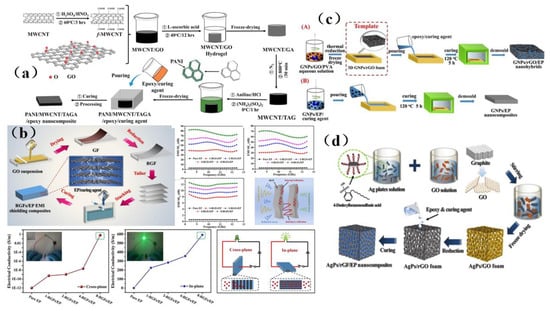

Figure 7. (a) Preparation schematic diagram and performance test of PANI/MWCNT/thermally annealed graphene aerogel/epoxy electromagnetic interference shielding nanocomposites. (b) Schematic depiction of the fabrication process leading to RGFS/EP EMI shielding composite material. (c) aA: Schematic diagram of the preparation pathway leading to three-dimensional GNPs/rGO/EP nanocomposites by the template method, bB: Schematic diagram showing the preparation of GNPs/EP nanocomposites by a traditional blending casting method. (d) Schematic diagram showing the preparation of three-dimensional AgPs/rGF/EP nanocomposites.
The separation structure formed in carbon-based composites has great advantages in improving the electromagnetic interference shielding performance. However, due to the limitation of processing methods and the severe deterioration of mechanical properties, t the practical applicability of this composite is limited. Zhang et al. [97][141] prepared a separated carbon nanotube/polypropylene (CNT/PP) composite by simple and environmentally friendly methods such as pre-coating, melt mixing, and injection molding (Figure 8a). The material not only has good at shielding performance, but also has good tensile strength and a desirable Young’s modulus, which provides a feasible method for the separation and compounding of carbon-based shielding materials. Song et al. [98][142] prepared a CCA@rGO/PDMS EMI shielding composite materials using a backfilling method (Figure 8b), and obtained the best shielding performance of 51.0 dB, excellent thermal conductivity, robust mechanical properties, and good thermal conductivity. This excellent comprehensive performance suggests that cellulose carbon aerogel (CCA)@rGO/PDMS electromagnetic shielding composite material may have prospects for use in light and flexible electromagnetic shielding composite materials. In addition, thin membranes are an ideal choice for electromagnetic interference shielding because of their ultra-thin planar structure, light weight properties, good flexibility, and facile preparation process. Hu et al. [45] prepared a multifunctional aerogel membrane composed of strong aramid nanofibers (ANFs), conductive carbon nanotubes (CNTs) and hydrophobic fluorocarbon (FC) resin (Figure 8c), which has a large specific surface area (232.8 m2 G1), high conductivity (230 S·m−1), and excellent hydrophobicity (its contact angle can reach 137°). Guo et al. [99][143] prepared a multi-functional layered carbon-based composite membrane with graphene oxide/expanded graphite (GO/EG) as the top heat conduction and EMI shielding layer by adopting the layered design and assembly strategy (Figure 8d). The composite membrane has a high in-plane thermal conductivity (95.40 W (m·K)−1), an excellent EMI shielding effect (34.0 dB), good tensile strength (93.6 MPa) and fast electric heating response (5 s), and is thus a promising candidate for a broad range of applications


Figure 18. (a) Schematic diagram showing the preparation of separated carbon nanotubes/polypropylene composites and their performance evaluations. (b) Schematic diagram of the manufacturing process leading to CCA@RGO/PDMS electromagnetic interference shielding composite material. (c) Schematic diagrams showing the preparation, and multifunctional characteristics of FC-ANF/CNT mixed gas gel membrane. (d) Schematic diagram of preparation process of PI composite membrane.
As the lightest and thinnest material known in the world, carbon-based materials have excellent conductivity, high aspect ratios, large specific surface areas, abundant functional groups, ultra-light weight, and thus they have great application potential as electromagnetic/radiation shielding materials. Carbon-based membrane shielding materials have high thermal conductivity, high inherent tensile strength, and high elastic moduli, which provides them with unique advantages for applications as multifunctional electromagnetic shielding materials. In order to ensure that these types of membrane shielding materials can better meet future technological needs, there are still many challenges that must be addressed, such as reducing their cost, and improving their flexibility, corrosion resistance, thermal conductivity, transparency, and environmental stability. In the future, researchers will still need to develop new methods, find new materials, and optimize the construction technology of multiple composite structures to effectively improve the performance of carbon-based electromagnetic shielding materials, and make them multifunctional (high thermal conductivity, corrosion resistance, and high transparency) and intelligent on the basis of meeting the performance requirements of “thinness, lightness, strength, and width”. Successfully achieving these goals will greatly expand the applicability of carbon-based electromagnetic shielding materials. A wide range of carbon-based materials were highly favored for their excellent properties, such as being light weight, having excellent flexibility, extraordinary electrical properties and corrosion resistance, which make great contributions to electromagnetic interference shielding and other applications. The disadvantage of carbon-based electromagnetic interference shielding materials is their low impedance matching caused by high conductivity, which leads to high reflection and low absorption.
2.4. Iron-Based Membrane Shielding Materials
Due to impedance mismatch, most electromagnetic waves will be reflected at the interface between the composite and the air, which will cause electromagnetic pollution to to be released into the surrounding environment [100][101][144,145]. The research shows that the introduction of magnetic materials can improve the impedance matching performance between composite materials and air, weaken the reflection of electromagnetic waves, and absorb electromagnetic waves through magnetic loss [102][103][146,147]. Depositing magnetic nanoparticles (Fe2O3, Fe3O4, NiFe2O4, etc.) onto conductive fillers can not only enhance their EMI SE, but also achieve insulation modification and solve the contradiction between excellent electromagnetic interference shielding and electrical insulation performance [104][148].
Wang et al. [105][149] used a Ti3C2Tx@Fe3O4/CNF aerogel (BTFCA) to prepare BTFCA/epoxy nanocomposites with a long-distance layered structure (Figure 19a). Due to the introduction of Fe3O4, BTFCA is endowed with excellent magnetism. In addition, the composite can retain its original long-distance layered structure and maintain structural integrity. This is mainly because the high rigidity of Fe3O4 also provides BTFCA with a high degree of rigidity, which allows BTFCA/epoxy nanocomposites to retain the integrity of the layered structure arranged remotely (Figure 9b). In order to improve the electrical insulation performance of electromagnetic interference, the influence of internal conductive materials can be reduced by the structural design of composite materials and the insulation of the outer layer of the sandwich structure. Guo et al. [104][148] prepared a sandwich structure of CF@Fe2O3/(BN/Sr) composite material by depositing Fe2O3 particles onto carbon fiber (CF) with CF @Fe2O3 as filler (Figure 9c). Its structure can not only realize the heat conduction and electrical insulation functions of composite materials, but also achieve excellent EMI shielding performance and reduce secondary electromagnetic pollution through an “absorption-reflection (transmission)-reabsorption” process when electromagnetic waves pass through conductive fillers bearing magnetic materials. In addition, the CF@Fe2O3/(BN/SR) composite material was found to exhibit a better heat dissipation effect (5.6 °C) than commercial silicone grease (QM850) when it was evaluated on a computer CPU as a test platform. In addition, it has wide-ranging application prospects in the electronics field. As dipolar materials, Fe2O3 materials polarize in the presence of these waves, which leads to higher attenuation of electromagnetic waves. In order to efficiently construct a three-dimensional magnetic graphene-based composite structure and significantly improve electromagnetic interference, Liang et al. [106][85] prepared a three-dimensional Fe3O4-modified carbon nanotube/reduced graphene oxide foam/epoxy (3 Fe3O4-CNTs/RGF/EP) nanocomposite (Figure 9d). Subsequent performance tests revealed that its conductivity reaches 15.3 S/m and its EMI SE value reaches 36 dB, which is increased by nearly 482% compared with the composite material, which lacks a 3D structure. The introduction of Fe3O4 nanoparticles in the study will increase the magnetic and dielectric losses, on the one hand, due to the interface polarization between Fe3O4 nanoparticles, and other materials, and on the other hand, due to the formation of heterogeneous systems and stronger coupling between adjacent Fe3O4 nanoparticles, which will polarize in the presence of electromagnetic fields, thus obtaining better electromagnetic wave absorption. Therefore, excellent magnetism and efficient three-dimensional skeleton structure were the primary factors for the excellent electromagnetic shielding performance of three-dimensional Fe3O4-CNTs/rGF/EP nanocomposites (Figure 9e).
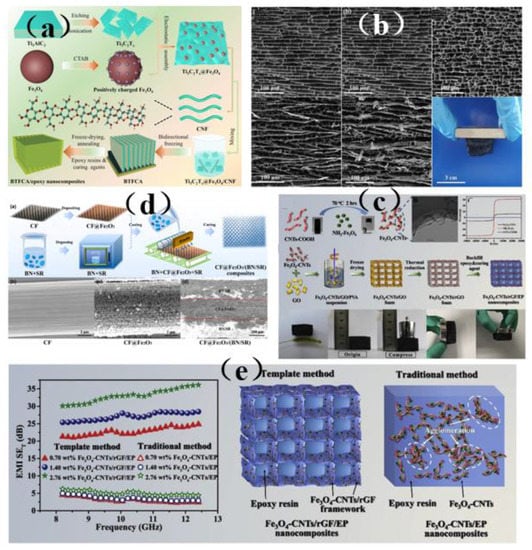

Figure 9. (a) A schematic diagram of the preparation process leading to the BTFCA/epoxy nanocomposite. (b) Morphology of BTFCA and BTFCA/ epoxy nanocomposites. (c) Schematic diagram and microstructure of CF@Fe2O3/(BN/Sr) composites. (d) Operating temperature of CPU. (e) Comparison of EMI SET of Fe3O4—CNTs/EP and 3D Fe3O4—CNTs/rGF/EP nanocomposites physically blended by different preparation methods.
Although iron oxide has excellent magnetic properties and strong spin polarization at room temperature, it can be used to absorb microwave radiation. However, Fe3O4 nanoparticles tend to aggregate due to their strong magnetic dipole-dipole interaction, which affects the shielding effectiveness. To solve these problems, Liu et al. [43] prepared a three-dimensional porous graphene/Fe3O4/epoxy nanocomposite (Figure 10a), which can effectively prevent agglomeration and has excellent thermal stability as well as mechanical properties. Wang et al. [107][150] functionalized Fe3O4 nanoparticles with silver and 11 mercaptononanoic acid (MUA), and they reacted Fe3O4@Ag-COOH nanoparticles with the acyl amine of MWCNTs-NH2 to obtain conductive and magnetic layered composite nanoparticles MWCNT-Fe3O4@Ag (Figure 10b). The functionalized nanoparticles were readily dispersible in the composite material. Yiming et al. [108][151] used ethylenediamine functionalized Fe3O4 (NH2-Fe3O4) nanoparticles and graphene oxide (GO) to prepare a composite material with high shielding effectiveness (Figure 10c), which can be readily dispersed with graphene to obtain excellent shielding performance. Chen et al. [3] prepared PS composites with high electrical conductivity and electromagnetic shielding effectiveness by blending modified Fe3O4 nanoparticles with other solutions (Figure 10d). The modified nanoparticles were easily dispersed in the solution, exhibiting a synergistic effect with other materials, showing a good microwave absorption effect, and greatly enhancing the shielding performance.


Figure 10. (a) Schematic diagram of porous GNP/ Fe3O4/epoxy nanocomposites prepared by epoxy-water-inorganic filler suspension emulsion polymerization. (b) Schematic diagram of general preparation process of MWCNT-Fe3O4@Ag/epoxy resin nanocomposite. (c) Preparation schematic diagram of Fe3O4/TAGA/epoxy nanocomposite. (d) Schematic diagram of the synthesis of (a) PS/ Fe3O4@RGO and (b) PS/TGO/Fe3O4 composites.
Besides iron oxide, the FeNi alloy also has excellent initial permeability, relative permeability, low coercivity, as well as repeated magnetization loss, and thus it has great potential in EMI shielding applications. Song et al. [109][152] loaded functionalized FeNi alloy particles (f-FeNi) on a graphene oxide aerogel with a regular honeycomb structure (GH), and they prepared a magnetic and conductive rGH@FeNi/epoxy electromagnetic shielding composite (Figure 11a). Its shielding efficiency is as high as 46 dB, and at the same time, it has good thermal stability (its heat-resistance index and temperature at the maximum decomposition rate were 179.1 °C and 389 °C, respectively. Yang et al. [110][153] embedded a FeCoNi medium entropy alloy in a one-dimensional carbon matrix frame to prepare a composite electromagnetic wave absorber (Figure 11b), which significantly enhanced the electromagnetic wave absorption performance. Guan et al. [111][154] prepared highly dispersed fine FeNi nanoparticles (NPs) that were coated with carbon nanofibers (FeNi@CNFs) (Figure 11c), for use in shielding materials to obtain a satisfactory synergy of impedance matching and attenuation resistance. The use of FeNi NPs was an effective and promising strategy for designing light and high-performance electromagnetic wave absorbers.
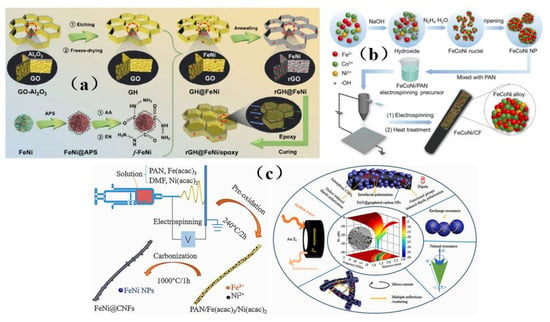

Figure 11. (a) Schematic diagram showing the preparation of an RGH@FeNi/epoxy composite. (b) Schematic diagram of the synthesis strategy leading toFeCoNi/CF composites. (c) Schematic diagram and mechanism diagram of the manufacturing process leading to FeNi@CNFs.
In short, from the perspective of application, the membrane shielding materials incorporating iron and its oxides are very useful in energy, medical treatment, research, and many other fields. ReIn this searchersction, we have explored the composite materials composed of carbon, polymer, and iron-based materials, in which iron is an important component that can prevent electromagnetic interference (EMI) through reflection and absorption. Dielectric loss and magnetic loss are the reasons for high microwave absorption and total shielding performance. In this case, iron and its components can be combined with conductive polymers, carbon-based materials, or other materials to achieve a synergistic effect, which has become a popular strategy for EMI shielding applications. This approach also likely points the way for the future development of electromagnetic shielding materials that are lighter, thinner, less costly, and offer superior absorption performance compared to that of the existing materials.
2.5. Cellulose-Based Membrane Shielding Materials
At present, most membrane shielding materials are made by combining highly conductive elements with substrates by various methods, such as coating or mixing. However, numerous reported membranes shielding materials were based on non-renewable polymers [39][40][41][42][43][44][45][46][47][48][49][50][39,40,41,42,43,44,45,46,47,48,49,50], which is inconsistent with the concept of green chemistry and sustainable development. Therefore, some biopolymers have attracted the attention of researchers [54][112][54,155]. As the most abundant renewable polymer on earth, cellulose is widely used in various fields because of its excellent characteristics, including low production cost, biodegradability, biocompatibility, and being light in weight [113][156]. Cellulose contains many hydroxyl groups, which may promote the formation of hydrogen bonds, which can promote the combination of cellulose with other elements. Generally, cellulose composites are prepared in the form of membranes, papers, or porous materials. Cellulose serves as a matrix in composites, which can improve the mechanical properties of these materials. At the same time, it can be used as a dispersant to evenly distribute nanoparticles and reduce the content of conductive components, thus yielding a thin and efficient EMI shielding material [112][155].
Zhou et al. [70] designed a multilayer membrane with an alternating structure comprised of cellulose nanofiber (CNF) layers and MXene layers by alternating vacuum filtration (Figure 12a). Based on the mechanical frame effect of the CNF layers, the nano-zigzag cracks in the MXene layer can be effectively prevented from spreading to the whole membrane, and the mechanical strength and toughness of the alternating multilayer membrane (CNF@MXene) are improved. It can withstand more than 1000 folding tests without becoming damaged, and the shielding efficiency was as high as 40 dB, paving the way for the application of new intelligent protection equipment suitable for cold and complex conditions. Han et al. [114][157] compounded aramid nanofibers (ANFs) that were prepared by a chemical dissociation method with other fillers, thus obtaining a thermally conductive and electromagnetic interference shielding composite membrane (Figure 12b) with a Janus structure (boron nitride nanosheets (BNNS)/ANF). This BNNS/ANF film exhibits both conducting as well as insulating behavior and has excellent electrical stability and reliability. Uddin et al. [115][158] simply soaked, carbonized, and integrated two-dimensional layered MoS2 with low conductivity into waste cellulose paper, which promoted absorption by optimizing the dielectric loss and green shielding by reducing reflection. This was mainly due to the introduction of two-dimensional stacked MoS2 sheets, which provided the source of interfacial polarization and multiple relaxation pathways. MoS2 also acts as a bridge between cellulose fibers, forming a conductive network, promoting conductive loss, and thus providing an effective strategy for sustainable manufacturing of high-performance green EMI shielding materials (Figure 12c,d).
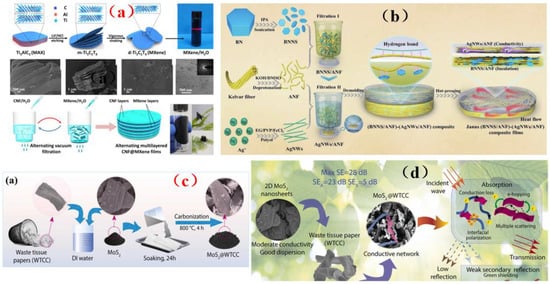

Figure 12. (a) A schematic diagram of the preparation of alternating multilayer membrane (CNF@MXene). (b) A schematic diagram of the preparation of (BNNS/ANF) -(AgNWs/ANF) thermal conductive composite membrane with Janus structure. (c) A schematic diagram depicting the synthesis of cellulose carbon (MoS2@WTCC) derived from waste paper towels decorated with MoS2. (d) The low conductivity of MoS2 and cellulose fiber structure produce an effective conductive network, which is essential to improve shielding performance and minimize secondary reflections.
Many studies show that the internal multilayer structure provides an important contribution toward shielding effectiveness. Qian et al. [42] designed a structure in which carbonized cellulose microspheres were inserted into the Ti3C2Tx MXene layer (CCM@MXene). A CCM@void@MXene composite membrane with an “egg carton” structure was obtained (Figure 13a). Cellulose can be integrated with Ti3C2Tx MXene to form a graded material to enhance microwave absorption or EMI shielding performance, and then show better conductivity and shielding efficiency. This graded porous egg box-shaped structure was a promising candidate for use in high-efficiency EMI shielding systems. Zhang et al. [116][159] designed a CNT interface/cellulose porous composite (Figure 13b) by adjusting the porous microstructure and the distribution of carbon nanotubes in the cellulose composite and achieved excellent shielding performance as well as good mechanical properties and low density. Its shielding effect reached 40 dB, and its modulus was 279 MPa g−1 cm3. This research can preserve the environment and pave an effective way for high-performance electromagnetic interference shielding materials, thus promoting many practical and advanced applications of cellulose. Rahman et al. [117][160] designed a cellulose-based membrane shielding material based on bacterial cellulose (BC), a flexible and multifunctional organic-inorganic hybrid membrane (BC-SiO2-TiO2/Ag) (Figure 13c). This material can be easily disinfected under ultraviolet irradiation from a lamp or natural light, and safely discarded or even recycled. Wu et al. [118][161] used superfine (1.4 nm) cellulose nanofibers to achieve physical and chemical cross-linking of MXene (PC-MXene) nanosheets, thus preparing PC-MXene membranes with good flexibility and high conductivity (Figure 13d). The addition of nano-cellulose reduces the insulation polymer gap between MXene nano-sheets, thus preventing the deterioration of the conductivity and EMI shielding performance of MXene/ polymer composites and enabling the fabrication of strong and ultra-thin film shielding materials.


Figure 13. (a) Schematic diagram showing the fabrication of CCM@void@MXene composite membrane (CVMF). (b) Schematic depiction of the preparation process leading to carbon nanotube matrix/cellulose porous composite (route 1) and carbon nanotube interface/cellulose porous composite (route 2). (c) Schematic diagram showing the preparation of cellulose-based membrane shielding material. (d) Schematic diagram of PC-MXene physical and chemical double cross-linking preparation process.
As electromagnetic shielding and absorbing materials, cellulose-based composites provide impressive performance while also having room for further expansion in terms of their performance, applications, and structural diversity. Besides their desirable characteristics, such as their low density, low cost, and good electromagnetic efficiency, other requirements such as corrosion resistance, thermal stability, and hydrophobicity cannot be ignored due to the diverse range of working environments that should also be considered. Therefore, there is still much room for innovation and growth in the research of cellulose-based materials in many aspects, and the road to maturity will be difficult and full of expectations. A helpful area for further research will be to gain deeper insight into the shielding mechanism of cellulose-based composites, and this knowledge will provide more new opportunities leading to the next generation of electromagnetic absorption shielding materials.
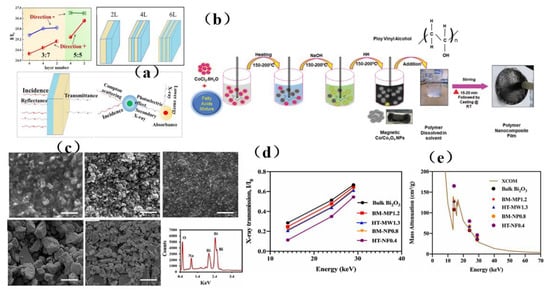
2.6. New Lead-Free Membrane Shielding Materials
Over the years, researchers at home and abroad have conducted a series of investigations on radiation shielding materials, and various radiation shielding materials have been developed. However, further research was needed to optimize the preparation process, enhance the radiation shielding performance, and improve the comprehensive performance of these materials [119][120][162,163]. Traditional radiation protection materials used for personal radiation protection have been rubber-based composite materials with lead and its compounds as the main filling materials. Because of their poor softness, strong toxicity, limited shielding effect, and other problems (especially their heavy weight and poor comfort), these materials cannot meet the actual requirements for safe and comfortable protective clothing [119][120][162,163]. In order to obtain ideal protective materials, it is necessary to prepare lead-free radiation protection composites with better flexibility and radiation shielding performance by optimizing composite component design and improving composite processing technology. In order to solve the lead pollution caused by the widespread use of lead-containing materials in shielding materials for radiation protection, technical approaches for utilizing lead-free composite shielding materials have been put forward. Li et al. [121][164] designed a lead-free multilayer polymer composite, which is a layered composite based on tungsten/octene copolymer)/(bismuth/octene copolymer). The shielding mechanism of this structure was primarily due to X-ray penetration becoming weakened by the synergistic effect of layers and interfaces, so that the X-ray shielding ability can be effectively enhanced (Figure 14a). Tiwari et al. [122][165] prepared a nano-composite membrane with a green surfactant (Figure 14b), which has excellent shielding effectiveness and is very suitable for commercial applications. Yu et al. [123][166] studied the influence of micro-nano Bi2O3 membranes with different morphologies on shielding performance, and they found a synergistic effect between the particle size and the morphology on low-energy X-ray attenuation (Figure 14c–e). Therefore, the synergistic effect of particle size and morphology should be considered during the design of effective radiation-proof clothing.
Figure 14. (a) a: Relationship between X-ray transmittance and layer thickness ratio (4:6 and 3:7), incident direction and number of layers, b: Structural schematic diagram of a multilayer composite materials with different layers, c: Schematic diagram of a photon attenuation mechanism. (b) Synthesize NPs, and then make thin membrane. (c) SEM image of the top section of the prepared thin membrane and EDX analysis of Bi2O3 bulk. (d) X-ray transmission of bulk Bi2O3, BM—MP1.2, HT—MW1.3, BM—NP0.8 and HT—NF0.4. (e) Get the mass attenuation coefficient of bulk Bi2O3 from XCOM, and comparison with the corresponding value of each experimental sample.
In summary, the current research mainly focuses on the lead-free radiation shielding materials that can be used as radiation shielding materials. According to the cost performance, practicability and physical properties of lead-free materials, there are many kinds of lead-free materials that can be suitable for applications as radiation shielding materials. Lead-free radiation-proof materials are lightweight and have good protective performance. Therefore, future medical radiation protection clothing must be light, efficient and environmentally friendly, so as to improve the working comfort for medical staff, ensure their health and safety, and not contaminate the environment with lead or other toxic materials. Finally, no matter what kind of shielding agent is added to medical radiation protective clothing, in addition to its radiation protection performance, many factors such as mechanical properties, preparation difficulty, impact on the environment, cost, and so forth. should be considered to meet the national standards of medical protective clothing.
